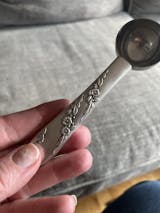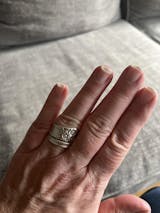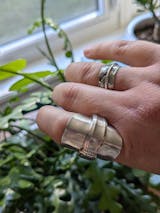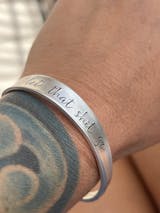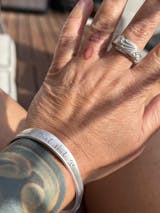I received my sunflower ring yesterday! I’m in love with it. Nice quality and has a bit of weight to it. I also got a tea spoon for measuring my morning tea. I’m so very happy with both, beautiful craftsmanship xo
My second order from Callista Faye arrived this morning. I was surprised since it had been caught in the Canada Post strike and I had no idea when it would arrive. I was so pleased since I had ordered several items and they were all perfect! I won't describe these items since they are family gifts to be given at a later date. Callista even included a few surprises so opening the package felt a little like Christmas morning. Callista,thank you so much!
I received a gift for my Daughter’s birthday it’s not until December but when I saw these heart necklaces I ordered two different ones both gifts, love ❤️ so much might Oder one for me .
I just received my Garland bracelet and it's perfection! I love it! Thank you!!
I bought 8 vintage necklaces last fall for all the special ladies in my life, our Moms, daughter, nieces & BFFs. Each piece was special and personal and they all love them.
Customer service, quality and delivery were amazing. Love buying as local as possible…Callista made it so easy.
I've ordered 5 or more pieces from callistafaye and I love each and every one of them so very much! Quality craftsmanship, beautiful work, gorgeous designs! Delivery is quick and efficient as well! I LOVE this girl and her store, I'll continue to order when I need or want an item with confidence and excitement! :D
I absolutely LOVE my spoon ring! It is such a statement piece. I love that it is made from the entire spoon, not just the handle. It is incredibly comfy/lightweight to wear as well, despite its size. Couldn't be happier with this one-of-a-kind purchase!
My order of 5 floating heart necklaces arrived in a very timely manner today. It is so nice to see my Mother's silver transformed into such meaningful pieces for her great granddaughters. As they grow older I hope they will value this link to their family history. I am so pleased with the entire order including the little velvet bags. Thank you Callista for your excellent work and your attention to detail!
Received my beautiful stamped bangle and ring today! I’m so happy with both pieces, I love rustic, handmade jewelry.
I’ll be ordering again!
Thank you
I have purchased a Tiffany earrings for my daughter’s 18th birthday. One of the things I like best about Tiffany jewelry is the stamped feature. There is something so industrial, basic & historic about the approach of stamping silver. I use silver plate everyday in my kitchen as I love the patina, weight and beauty of the pieces.
I was viewing key chains by Tiffany and felt the pricing was outrageous, which led me to this website. I found these beautiful heart shaped key chains. I ordered one for my daughter with her birth date stamped on it. Hers is the bridal wreath pattern from the 1950’s. I ordered a park lane heart key chain for myself which is vintage 1936. My third purchase was a stamped spoon key chain for my Dad who is a Huge, Beatle fan. “All we need is love”, can’t wait to give it to him for his birthday!
My next purchase will be a coffee scoop, what a fabulous piece.
Callista, what a talented artist you are. I love what you are producing and presenting to the world.
I came across your Easy Plaid Crochet Blanket pattern over a year ago on YouTube and I loved it! I had to try it.
I just finished my version of the pattern. I am a visual learner and your video was a very clear and concise explanation. Thank you for sharing. This is a gift for my son-in-law.
Callista is an incredible artist that works very hard to create unique pieces. Most of my daily jewelry is her work, I have been wearing it for years and it has held up beautifully. Beyond her incredible work, the customer experience is seamless. Shipping is fast and the packaging is gorgeous. While I love to treat myself with her products, Callista’s work has also become my go to gift for any occasion. I love gifting personalized wedding sets to newlyweds, swear spoons to my friends who are having a tough week, initial and birth flower jewelry to the mamas in my life… there is truly something for every occasion and I love gifting these pieces that have such special meaning and are of the highest quality.
I ordered the Sister heart necklace and my sister LOVES it! Made the other sister jealous, so now I have to order another one. :) Fast shipping w/ tracking. Definitely recommend.
I’ve purchased a few pieces from Callista, including a custom mini bead necklace. It was easy to contact her and discuss different ideas when I couldn’t find exactly what I was looking for on the website. She gave great design advice and provided sample pictures to make sure I was happy with my choices. I love the pieces she makes and the turnaround time was practically overnight!
I highly recommend Callista Faye Creative if your looking for anything antique this Holiday season! Her page is full of neat things!!
This review is long overdue. I have purchased several wonderful items from Callista. My first purchase was a butter knife for a gift and a key chain for me, both were awesome. I then went back for more items for myself, a great heart shaped spoon necklace which I love and wear all the time and 3 rings (was planning of gifting one but couldn’t part with it). So if you are looking well made beautiful things for yourself or for a gift look no further. Each item comes with a little bit of the silverware’s history, like it’s style and year of the pattern.
Callista, I love the pendant. Everything about it is perfect. Great job, thanks again. :)
I love that you used an old sewing pattern for tissue paper! Both pieces are gorgeous, thanks Callista!
Hi Callista, I recieved the ornaments today. They are GORGEOUS!!! I love them!! Thank you so much!!


